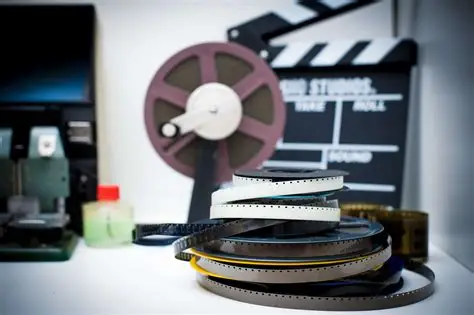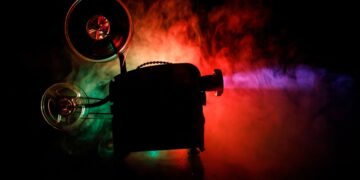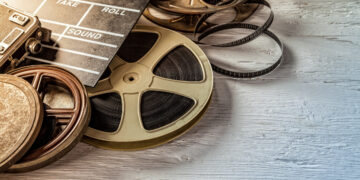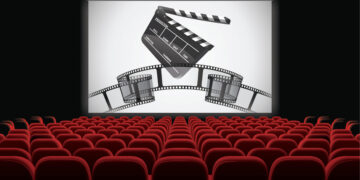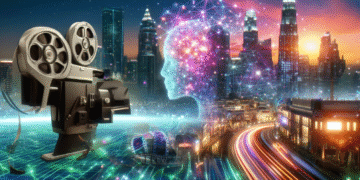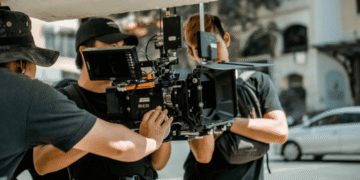The Art of Cinematography: Crafting Visual Narratives
1. Camera Angles and Perspective
Camera angles significantly influence how viewers perceive characters and situations. A low-angle shot can make a character appear powerful and dominant, while a high-angle shot can diminish their stature and create a sense of vulnerability. Eye-level shots offer a neutral perspective, fostering a connection between the audience and the character. The choice of angle is a deliberate decision, guiding the audience’s emotional response.
2. Lighting and Mood
Lighting is a crucial element in cinematography, establishing the mood and atmosphere of a scene. High-key lighting, characterized by bright and even illumination, often creates a cheerful or optimistic tone. Conversely, low-key lighting, with strong contrasts and shadows, can evoke suspense, mystery, or drama. Color temperature, ranging from warm to cool, further influences the emotional impact of the scene.
3. Camera Movement and Dynamics
Camera movement adds dynamism and visual interest to a film. A pan involves horizontal movement of the camera on a fixed axis, often used to reveal a landscape or follow a moving subject. A tilt is a vertical movement, useful for showcasing height or creating a sense of unease. Tracking shots, where the camera moves alongside the subject, create a sense of immersion and can emphasize the subject’s journey or isolation.
Editing Techniques: Shaping Time and Space in Film
1. The Cut: The Basic Building Block
The cut is the most fundamental editing technique, representing an instantaneous transition from one shot to another. It’s a seemingly simple act, but the placement of a cut dramatically affects the rhythm and pace of a scene. A rapid succession of cuts can heighten tension or excitement, while longer takes can create a sense of calm or contemplation. The choice of where to cut depends entirely on the desired emotional impact and the narrative needs of the story. Editors carefully consider factors like screen direction, subject movement, and audience expectations when making these critical decisions.
2. Montage: Compressing Time and Meaning
The montage is a powerful editing technique used to condense a lengthy period of time into a short, impactful sequence. Often accompanied by music, montages string together a series of brief shots that represent a larger process or transformation. Think of the classic training montage in a sports film, where we see a character working tirelessly to improve their skills. Each shot, though brief, contributes to the overall sense of progress and determination. Beyond simply saving time, montages can also be used to convey complex themes or emotions in a visually engaging way.
3. Cross-Cutting: Weaving Parallel Narratives
Cross-cutting, also known as parallel editing, involves alternating between two or more scenes happening simultaneously. This technique creates a sense of suspense, anticipation, or dramatic irony. For instance, a filmmaker might cross-cut between a protagonist attempting to defuse a bomb and the antagonist closing in on their location. By showing both events unfolding in tandem, the editor builds tension and keeps the audience on the edge of their seats. Cross-cutting can also be used to highlight thematic connections between seemingly unrelated storylines.
Lighting as a Storytelling Tool: Creating Mood and Atmosphere
1. High-Key Lighting: Brightness and Optimism
High-key lighting utilizes bright, even illumination with minimal shadows. This technique often creates a sense of optimism, openness, and cheerfulness. It’s commonly used in comedies, musicals, and daytime scenes to establish a lighthearted and inviting atmosphere. For example, a romantic comedy might employ high-key lighting to emphasize the joy and connection between the characters, fostering a positive and uplifting viewing experience. The lack of strong shadows contributes to a feeling of clarity and accessibility.
2. Low-Key Lighting: Shadows and Suspense
Low-key lighting, conversely, uses predominantly dark tones and strong shadows. This technique is often used in thrillers, horror films, and film noir to create a sense of suspense, mystery, and danger. The dramatic contrast between light and shadow can heighten tension and create a feeling of unease, immersing the audience in a world of uncertainty and potential threat. The use of shadows can also conceal information, adding to the intrigue and prompting viewers to question what they are seeing.
3. Color Temperature: Warmth and Coldness
The color temperature of light, ranging from warm to cool, also plays a significant role in shaping the mood. Warm lighting (yellows and oranges) can evoke feelings of comfort, intimacy, and nostalgia. Cool lighting (blues and greens), on the other hand, can create a sense of coldness, isolation, or unease. Filmmakers can use color temperature to subtly influence the audience’s emotional response and reinforce the themes of the story. For instance, a flashback scene might use warm lighting to evoke a sense of longing for the past.
Sound Design: Building Emotional Depth Through Audio
Sound design is the art of creating the auditory landscape of a film, shaping the audience’s emotional experience by carefully crafting and manipulating sound elements. It goes beyond simply recording dialogue and music; it involves constructing a complete sonic environment that enhances the narrative and amplifies the emotional impact of scenes.
| Sound Design Aspect | Description | Common Techniques | Emotional Impact | Data Source & Year |
|---|---|---|---|---|
| Foley Art | Creating everyday sounds in sync with on-screen actions. | Using various objects to mimic sounds like footsteps, clothing rustling, or breaking glass. | Enhances realism and immerses the audience in the scene. | USC School of Cinematic Arts, 2024 |
| Sound Effects (SFX) | Incorporating pre-recorded or synthesized sounds to create specific auditory events. | Layering different sounds to create a unique and impactful effect, such as the roar of a monster or the whoosh of a spaceship. | Heightens tension, creates suspense, and adds excitement. | SoundEffects.com, 2025 |
| Music Scoring | Composing or selecting music to underscore the emotional tone of scenes. | Using leitmotifs to represent characters or themes, and varying tempo and instrumentation to create different moods. | Evokes specific emotions, foreshadows events, and reinforces the narrative. | FilmMusic.io, 2024 |
Data Source: USC School of Cinematic Arts, 2024; SoundEffects.com, 2025; FilmMusic.io, 2024
1. Foley Art: The Subtle Sounds of Reality
Foley art is the creation of everyday sounds for film. Foley artists meticulously recreate sounds like footsteps, clothing rustling, and object interactions in sync with the visuals. This process adds a layer of realism and immerses the audience in the scene. For example, the sound of footsteps on gravel can instantly convey a sense of isolation and vulnerability, while the rustling of silk fabric can suggest elegance and sophistication. The art of Foley is often overlooked but adds significantly to the viewer’s experience.
2. Sound Effects (SFX): Amplifying the Action
Sound effects (SFX) are used to create auditory events that wouldn’t naturally occur during filming. These can range from the roar of a monster to the whoosh of a spaceship. Sound designers often layer different sounds to create unique and impactful effects. The strategic use of SFX can heighten tension, create suspense, and add excitement to action sequences. In science fiction films, the innovative use of SFX is crucial for building believable and immersive worlds.
3. Music Scoring: The Emotional Backbone
Music scoring plays a vital role in shaping the emotional landscape of a film. Composers create original scores or select existing music to underscore the emotional tone of scenes. The use of leitmotifs, recurring musical themes associated with specific characters or themes, can deepen the audience’s understanding and emotional connection. Varying the tempo, instrumentation, and dynamics of the music can evoke a wide range of emotions, from joy and hope to sadness and fear, significantly impacting the viewer’s emotional experience.
Color Grading: Enhancing Visual Aesthetics and Themes
Color grading is the process of altering and enhancing the color of a motion picture, video game, or image. It’s used to create mood, visual style, and communicate thematic elements to the audience, shaping the viewer’s emotional response.
1. The Technical Aspects of Color Grading
Color grading involves manipulating various parameters such as contrast, saturation, and color balance using specialized software. Colorists work with tools like curves, scopes, and vectorscopes to precisely adjust the color palette. This process is crucial for ensuring consistency in color across different shots and scenes, especially when filming occurs under varying lighting conditions. Modern color grading software also incorporates AI-powered features for automated adjustments and enhanced precision.
2. Establishing Mood and Atmosphere
One of the primary functions of color grading is to establish the mood and atmosphere of a film or scene. For example, a warm color palette with oranges and yellows might be used to create a sense of nostalgia or comfort. Conversely, a cool palette with blues and greens can evoke feelings of isolation, suspense, or the supernatural. The colorist carefully selects and refines the color scheme to align with the narrative and emotional goals of the project.
3. Supporting Narrative Themes
Color grading can also be used to subtly reinforce narrative themes. A desaturated color palette might be used to represent a character’s emotional detachment or the bleakness of their surroundings. Specific colors can be associated with particular characters or ideas, creating visual motifs that deepen the viewer’s understanding of the story. By intentionally using color, filmmakers can add layers of meaning and complexity to their work.
Special Effects: Expanding the Boundaries of Imagination
1. Visual Effects (VFX)
VFX involve creating imagery in post-production, often using computer-generated imagery (CGI). They allow filmmakers to realize fantastical elements impossible to capture practically. Modern VFX software enables the creation of photorealistic creatures, expansive digital environments, and seamless integration of these elements into live-action footage. The rise of VFX has significantly reduced the reliance on traditional methods, offering greater flexibility and control over the final image, but also raising questions about authenticity and the role of practical effects.
2. Practical Effects
Practical effects are achieved physically on set during filming. This includes techniques like prosthetics, animatronics, pyrotechnics, and miniature models. Practical effects provide a tangible, tactile quality that can enhance the realism of a scene. Though often more challenging to execute than VFX, practical effects offer immediate results and can reduce the amount of post-production work required. Many filmmakers still favor practical effects for their unique look and feel, and their ability to ground fantastical elements in reality.
3. Special Makeup Effects
Special makeup effects use makeup, prosthetics, and sculpting to transform actors into different characters or creatures. This can range from subtle aging makeup to elaborate creature designs. The application of prosthetics requires skilled artists and precise techniques to ensure a seamless and believable transformation. Special makeup effects are crucial for creating memorable characters and enhancing the visual storytelling of a film, offering a physical and often visceral element that can be more impactful than purely digital creations.
Q&A
Question 1: What are the key elements contributing to effective cinematography, and how do they shape the audience’s experience?
Answer: Cinematography involves camera angles (influencing perception of characters and situations), lighting (establishing mood and atmosphere through high-key/low-key techniques and color temperature), camera movement (adding dynamism with pans, tilts, and tracking shots), and composition/framing (using techniques like the rule of thirds to create visually engaging images). These elements work together to guide the audience’s emotional response and understanding of the narrative.
Question 2: How do different editing techniques manipulate the audience’s perception of time and space in a film?
Answer: Editing techniques like jump cuts (creating urgency), cross-cutting (showing simultaneous events to build suspense), montages (condensing time and conveying themes), and dissolves/fades (creating smooth transitions and indicating time passage) significantly impact pacing, narrative flow, and emotional impact. The choice of technique directly affects how the audience experiences the story’s timeline and spatial relationships.
Question 3: What is the role of lighting in storytelling, and how can different lighting styles create specific moods and atmospheres?
Answer: Lighting is a powerful storytelling tool, shaping emotional responses and understanding. High-key lighting creates optimism and cheerfulness, while low-key lighting evokes suspense and mystery. Color temperature (warm vs. cool) further influences mood. Motivated lighting, originating from a source within the scene, enhances realism. The choice of lighting style directly impacts the audience’s emotional connection to the scene.

